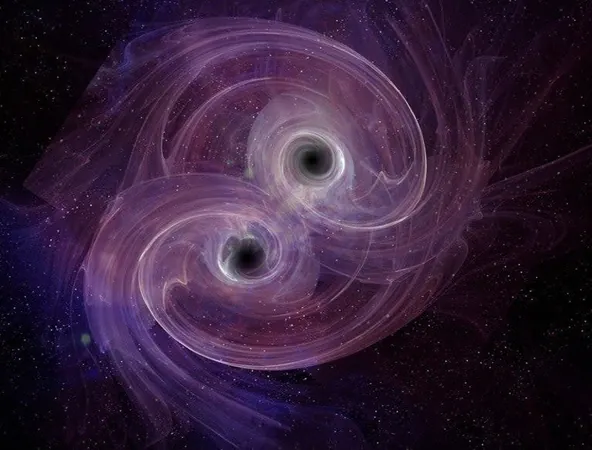
Einstein’s Legacy Strengthened: Hawking’s Black Hole Law Confirmed
2025-09-18
Author: Nur
Groundbreaking Confirmation of Hawking's Prediction
In an astonishing leap for astrophysics, researchers have confirmed one of Stephen Hawking's pivotal predictions regarding black holes—the notorious area law. This principle asserts that when two black holes collide, the total surface area of the resulting event horizon never diminishes. Instead, it always increases, reinforcing key aspects of Einstein's general relativity.
A Historic Milestone in Gravitational Wave Detection
In 2015, astronomers first detected gravitational waves from the merger of two black holes, a monumental moment known as GW150914. Fast forward to today, and scientists have utilized the most powerful gravitational wave signal ever recorded—GW250114—to put Hawking's area law to the ultimate test.
The Loudest Wave to Date—A Game Changer
Captured by the Laser Interferometer Gravitational-Wave Observatory (LIGO) alongside teams from Virgo and KAGRA, GW250114 boasted a signal-to-noise ratio of 80—a record-breaking clarity. As Geraint Pratten from the University of Birmingham eloquently puts it, 'It was like a whisper becoming a shout,' allowing scientists to rigorously examine Einstein’s theories in unprecedented detail.
Impressive Findings from the Cosmic Collision
Before their historic merger, the two black holes were each about 32 times heavier than the Sun, amounting to a combined surface area roughly the size of the United Kingdom. Post-collision, they formed a new black hole with a horizon area nearly the size of Sweden, ballooning to about 400,000 square kilometers. This remarkable increase surpassed the initial areas by a confidence level of over 4σ, changing the game for astrophysics.
Decoding Black Hole 'Voices'
The clarity of GW250114 also allowed researchers to identify specific quasinormal modes—vibrational patterns akin to the ringing of a bell. With a dominant frequency of 247 hertz, this discovery confirmed that the observed black holes behaved as predicted by the Kerr metric, which describes the effects of rotation on spacetime.
An Independent Verification of Einstein’s Theory
What sets this study apart is its independence from pre-existing assumptions. Researchers meticulously analyzed the signals before and after the merger separately, yielding robust evidence that the final surface area indeed surpassed the sum of the initial ones—providing strong support for Hawking’s principle.
A Major Victory for General Relativity
This confirmation serves as a monumental endorsement of Einstein's general relativity, demonstrating that even in the most extreme cosmic events, the theory holds true. Technological advancements have allowed detection of such powerful signals faster than many anticipated, paving the way for further exploration in this dynamic field.
The Path Ahead: Exploring the Cosmos Further
As gravitational wave detection capabilities continue to improve, future findings promise to unravel even deeper secrets of the universe. With upcoming upgrades to LIGO and the new space-based observatory LISA, scientists are poised to refine our understanding of black holes and their role in the cosmos.
Implications Beyond Astronomy
The implications of this research extend well beyond mere cosmic curiosity. Confirming that black holes function according to established physics reassures scientists that the frameworks we use to explore the universe remain reliable. Moreover, advancements in gravitational wave technology could ignite progress in various fields, from laser physics to precision measurements.
Closing Thoughts
As this groundbreaking research confirms Hawking’s vision and bolsters Einstein’s legacy, it highlights the intricate laws governing the universe and opens new paths for the exploration of black holes, quantum gravity, and the very fabric of reality.





 Brasil (PT)
Brasil (PT)
 Canada (EN)
Canada (EN)
 Chile (ES)
Chile (ES)
 Česko (CS)
Česko (CS)
 대한민국 (KO)
대한민국 (KO)
 España (ES)
España (ES)
 France (FR)
France (FR)
 Hong Kong (EN)
Hong Kong (EN)
 Italia (IT)
Italia (IT)
 日本 (JA)
日本 (JA)
 Magyarország (HU)
Magyarország (HU)
 Norge (NO)
Norge (NO)
 Polska (PL)
Polska (PL)
 Schweiz (DE)
Schweiz (DE)
 Singapore (EN)
Singapore (EN)
 Sverige (SV)
Sverige (SV)
 Suomi (FI)
Suomi (FI)
 Türkiye (TR)
Türkiye (TR)
 الإمارات العربية المتحدة (AR)
الإمارات العربية المتحدة (AR)